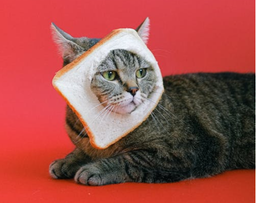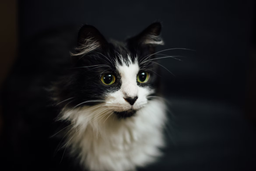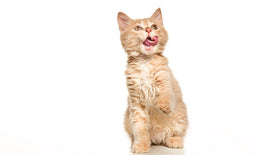How many pouches should I feed my kitten? Untamed suggests the best feeding solutions
Adult cats usually eat the same amount of food every day, but not kittens. Baby cats have fluctuating nutritional needs, so you should adjust their portions throughout kittenhood. If you're new to cat parenting, the question—How many pouches should I feed my kitten?—must have crossed your mind. Your internet search will probably offer conflicting results, but Untamed presents definitive answers. The number of pouches or tins your kitten needs should be customised to their:
- Development stage
- Activity levels (indoor or outdoor cats’ energy needs are pretty different)
- Health status
This comprehensive guide will help you determine precisely how many pouches or sachets of cat food per day your kitty should have. We’ll also look into suitable feeding plans and check out what type of food is ideal for your little kitty.
How many cat food pouches should a kitten eat per day?
Your kitten’s development stage is crucial for determining their daily rations.
As a general rule, younger kittens need more food per kilo of their body weight than older ones. Kittens are highly active and grow rapidly in the first six months of their life, so they need a high-calorie diet for basic sustenance. For the next six months, their growth slows down and ultimately stops once they have achieved their optimum adult weight.
Wet cat food tins/pouches/sachets in the UK usually come in 50–100 gram sizes, although the standard serving size is 70–85 grams. On average, cats need 3–6 tins/pouches/sachets per day during kittenhood, except during the weaning period.

Did someone say pouches? I don’t eat them, though. I prefer food.
Source: Tran Mau Tri Tam
How many pouches to feed a kitten who’s still weaning?
Most kittens start on solids when they are around three weeks old. Since they have tiny tummies at this age, they can only handle a limited amount of food at a time. Kittens usually need one or two packets or cans of wet food per day during the weaning period, generally lasting two to four weeks.
You should pay extra attention to the feeding frequency. Your kitten’s digestive tract is still developing, and you should not overwhelm it with too much food in a single serving.
The table below will give you a suggested feeding plan for weaning kittens:
|
Age |
Feeding frequency |
Amount per feeding |
|
3–5 weeks |
4–6 times a day |
14–35 grams |
|
5–8 weeks |
3–5 times a day |
40–80 grams |
Since one pouch can be anywhere between 50–100 grams, it’s likely a weaning kitty wouldn’t finish a whole product at a time. You should seal the unused food and store it in a refrigerator at 40 to 45 degrees Fahrenheit (about 4–7 degrees Celsius). Warm up the food to room temperature before the next serving. Once opened, wet food can be stored in the refrigerator for 5–7 days.
And weaned off kittens? How many sachets of kitten food do they need in a day?
The daily portions for weaned off kittens depend on the number of calories they need in a day. Refer to the following table for specifics:
|
Age |
Calories per day |
|
1–6 months |
250–400 |
|
6–12 months |
40–45 calories per kilo of their bodyweight |
Kittens under six months
Based on recommendations from top specialists, you can feed anywhere between three to six pouches or cans of standard wet food (size 70–85 grams) to a completely weaned-off kitten under six months. Here are some other factors that’ll help you determine the quantity:
- Body mass—The larger the breed, the more food you should offer. Average-sized kittens usually have 3–4 pouches in a day, but large-sized breeds like Ragdolls and Maine Coons might need 5–6 pouches to thrive
- Activity level—Playful and curious kittens spend more calories than their laid-back siblings. This is why active explorers like Siamese and Bengals often need more food than easy-going homebodies like Persians or British Shorthairs
- Health status—If you have rescued a malnourished or underweight kitten, you must feed them more pouches throughout the day until they gain healthy weight. Be careful with the serving size if the kitty is severely anorexic as their exhausted body can go into shock if they eat too much at a time. Reach out to a vet if you are not sure about the serving quantity or if you suspect your kitten needs medical attention
Kittens over six months
Once your kitten hits the six-month mark—i.e. enters the adolescence phase—you should taper down their portions. Kittens are close to adulthood at this age, so their nutritional needs shift from growth to sustenance. Most kitties also get spayed or neutered around this time, which decreases their energy requirements and daily caloric needs.

Spunky, rebellious teen kitties may want to eat what they like when they like it. But a fixed meal schedule will promote self-discipline and healthy eating habits.
Source: cottonbro
Older kittens feel full on two to four pouches or cans of standard wet food, depending on their current needs. If your kitty had three pouches per day during the first six months of their life, they would need only two as they transition into an adult.
What happens when you overfeed or underfeed your kitten?
Many cat parents say it’s impossible to overfeed a young kitten as they are constantly growing, but that is not true. Kittens who eat more than they should are at higher risk of developing poor eating habits and more likely to suffer from obesity and diabetes.
Overfeeding can also stress your kitten’s digestive system, triggering various gastrointestinal issues, such as nausea, diarrhoea, and vomiting (digested or undigested food).
Underfeeding can be equally detrimental to your kitty’s health. Malnourished kittens usually show the following symptoms:
- Lethargy and weakness
- Hair loss and patchy skin
- Poor bone, joint, and dental health
- Reduced appetite
- Low immunity
- Food sensitivity
- Bony physique
Keep in mind that setting up the right meal size for your kitten shouldn’t be your only concern. You should also ensure their food is nutritionally adequate and contains enough fat, protein, vitamins, and minerals to fulfil their carnivorous needs.

My tummy is not a bottomless pit, although I’d like it to be. Stop tempting me, hooman.
Source: Piotr Musioł
Are you feeding the right amount of the wrong food to your kitten?
There’s more to cat food than fixing the number of pouches. High-quality food is crucial to your feline’s overall health, irrespective of their age. Pay attention to the protein, fat, and carbohydrate content. Check out the table below for recommended values:
|
Nutrient |
Quantity |
|
Protein |
More than 50% |
|
Fat |
Up to 20% |
|
Carbohydrate |
Less than 3% |
If the product contains less protein or more carbohydrates and fat than recommended, it's not the ideal choice for your furry companion.
Protein
Cats need high-protein food to stay in top shape and get enough energy for their daily activities. A protein deficiency can lead to various health issues, such as poor eyesight, the loss of muscle tone, and different skin and coat conditions (often resulting in frequent hairballs).
Felines should get their proteins from whole meat because they can break down the essential amino acids, like taurine and arginine, and absorb them efficiently. The best protein sources for cats are tuna, duck, salmon, seafood, and chicken breast and liver. Avoid cat food with eggs, dairy, plants, legumes, and meat derivatives as protein sources because felines cannot properly digest this essential nutrient from anything other than meat.
Fat
Your kitty needs some fat in their diet to regulate body temperature, optimise hormone levels, and maintain skin health. Vets don’t recommend a high-fat diet for cats because it can lead to cardiovascular diseases and obesity.
Many manufacturers overload their products with fat as it improves the palatability of food. Some excellent protein sources are also rich in fat and shouldn’t be fed often or at all. When buying cat food, steer clear of products that contain eggs, beef, pork, lamb, and milk.
Carbohydrates
Being hardcore carnivores, cats do not need carbohydrates to survive as they get their energy from protein. Felines don’t have the necessary enzymes to efficiently break down any ingredient other than raw or cooked meat, so giving them carbs is useless.
Most cat food products are loaded with sugar, wheat, sweetcorn, rice or potato starch, and other grains and vegetables. These products may be advertised as “healthy” or “rich in fibre,” but carbs are redundant ingredients that compensate for the lack of meat in cat food.
Carbs can also be dangerous because they cause gastrointestinal problems and mess up your kitty’s blood glucose levels, causing diabetes.
Most nutritionists advise giving grain-free food to cats, preferably with whole meat and organs as the primary protein sources.
Wet food cans or pouches—what to choose?
Wet food is available in pouches and cans of different sizes. Both alternatives are sterilised and safe. Many pet food manufacturers have started offering disposable pouches that bring down the overall packaging cost. These single-use pouches are easy to handle and have a long shelf-life.
Unfortunately, pouches are not recyclable or environmentally friendly. They are made of different types of plastic, which must be divided, re-melted, and reshaped for recycling, but only for a limited number of times. The process is expensive and time-consuming, and the discarded pouches end up hogging space in landfills, clogging storm drains, and harming the wildlife.
Metal cans are infinitely recyclable, making them a more eco-friendly packaging solution. They are also super convenient to store and can keep the product fresh for a long time, thanks to the vacuum sealing mechanism.

Untamed says I can be on a sacred mission to save the environment while I eat. You want in, hooman?
Image (c) Untamed
Tasty, healthy, and ethically produced—Untamed ticks the right boxes!
At Untamed, we offer ethically produced and healthy wet food that’s easy to store and serve. Our catalogue includes:
- Complete gravy food, containing 63% whole meat
- Complementary jelly food, containing 60% whole meat
Our products are high-protein and low-fat, made only with prime cuts of human-grade whole meat and fish. Our highly digestible food is perfect for all cats, young or old!
Untamed brings high nutritional value to your cat's diet!
We aim to deliver the best to your furry companion. That’s why we pay special attention to:
- High-quality proteins—Our products contain real meat and not iffy fillers like grains, vegetables, and meat derivatives. We offer two times more protein than the industry standard
- Nutrient bioavailability—Our nutrient-dense recipes are designed by vets and provide the correct ratio of protein, fat, vitamins, and minerals cats need to thrive. We gently steam our food to preserve the bioavailability of essential nutrients like taurine and vitamin E
- Appeasing fussy eaters—Our dishes entice your feline’s senses because of the natural aroma, flavour, and texture of whole meat. If your kitty has a poor appetite, try tempting them with our various lip-smacking delicacies with ham, duck, tuna, salmon, shrimp, sardine, chicken, and mackerel
- Using allergen-free formulas—Untamed is minimally processed and free of all common allergens. Our single-protein Chocka Chicken and Tuck-in Tuna products are ideal for kitties prone to diarrhoea due to food allergies or stomach sensitivities
Take our TRY NOW quiz to tailor a meal plan for your kitty and order an Untamed taster pack at the best price!
Untamed is eco-friendly and convenient!
Untamed is available in compact 75g aluminium cans, the most cost-effective material to recycle! We are also Carbon Neutral Certified. Our products don’t require freezing or heating and have a shelf-life of three years.
We use meat and fish from sustainable, cruelty-free, and dolphin-safe sources.

Why pick a pouch when you can can? Pretty up your pantry with our gorgeous cans!
Image (c) Untamed
Kittens, adults, and seniors—Untamed is great for cats of all ages!
Here’s how we support kitties of all ages:
- Kittens—Our reliable, high-protein meals help kittens throughout the development phase, boosting their immune system and building up their muscle tone
- Adults—Since our delicacies are low-fat, they fit seamlessly in any weight management diet. The moisture content in our food also prevents urinary and renal ailments like cystitis and bladder stones
- Seniors—Cats tend to develop diabetes, anorexia, arthritis, and hyperthyroidism as they age. These illnesses can be delayed with a consistent intake of nutritionally balanced food. Untamed not only strengthens seniors with nourishing meals but can also boost their appetite and help them regain healthy weight
Our happy clients have noticed numerous positive effects after switching their feline friends to Untamed. The table below is an estimated timeline of these benefits:
|
Timeline |
The Untamed effect |
|
One week |
|
|
Two to four months |
|
|
Six months and up |
|
Here’s how to get Untamed
If buying cat food isn’t your favourite chore, you’ll love our hassle-free home deliveries. Go to our online cat food store to get your first Untamed taster pack—here's what you need to do:
- Complete our TRY NOW quiz
- Enter details about your cat
- Place your order
The taster pack will be at your doorstep within a day. Your kitty can sample our meals over the week, and if they give us the green light, we can start delivering monthly Untamed supplies. You don’t have to commit to anything even after choosing our monthly cat food subscription—modify, cancel, skip, or postpone an order anytime!

Keep your kitty healthy and happy with Untamed’s delicious meals!
Image (c) Untamed
What can kittens eat besides wet food?
According to vets, a regular wet food diet is the best for all cats—kittens included. Many cat parents are curious about dry, raw, or homemade food for kittens, so let's examine the pros and cons of these popular products.
Dry food
Cat biscuits are heavily processed and usually packed with carbs. Kitties on a kibble diet also tend to:
- Be dehydrated and suffer from related problems like constipation and IBS
- Throw up undigested food frequently
Vets do not recommend giving dry food to young kittens as they may get used to the artificially enhanced taste and reject wet food later. If you have to use biscuits, mix them with wet food before serving.
Raw food
Cats may hunt rodents, insects, and small birds in the wild, but giving them a diet of raw meat or bones—also called a B.A.R.F. (Biologically Appropriate Raw Food) diet—is risky. Uncooked meat can be contaminated during storage and handling even with all sanitary measures in place, so it’s not the safest option for felines, especially kittens with sensitive tummies.
Homemade food
Cooking homemade food for kittens can be expensive because you should consult nutritionists and then plan and prepare nutritionally adequate feline-friendly meals at home. If you love to cook for your kitty, try making simple unseasoned snacks like meat soups and bone broths instead of full meals.
Avoid adding potentially toxic ingredients to any homemade meal for your cat, which include:
- Root and stem veggies (onions, chives, garlic, etc.)
- Raw yeast
- Wild mushrooms
- Green tomatoes/potatoes
- Caffeine products like coffee and chocolate
- Grapes and raisins
As far as human snacks are concerned, you can give the following treats to your kitty, but strictly in moderation:

![Best food for Ragdoll cats in the UK [Broken Down]](http://untamed.com/cdn/shop/articles/featured_best_food_for_ragdoll_cats_uk.jpg?v=1646818249&width=256)

